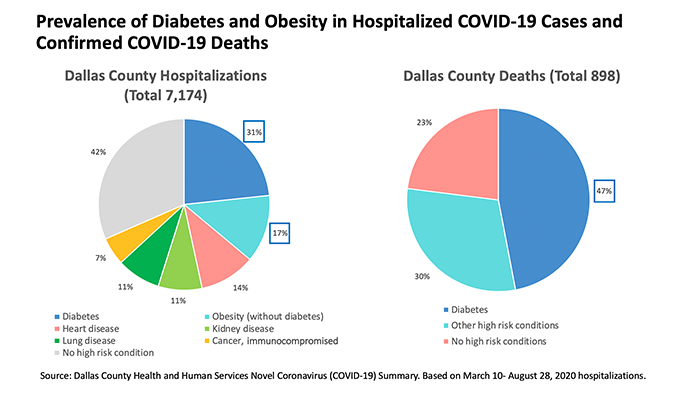Factors inherent to obesity could increase vulnerability to COVID-19
Inflammation in the lungs combined with high viral loads of the novel coronavirus create a perfect storm for obese patients with COVID-19, UTSW scientists say

DALLAS – Sept. 15, 2020 – Conditions related to obesity, including inflammation and leaky gut, leave the lungs of obese patients more susceptible to COVID-19 and may explain why they are more likely to die from the disease, UTSW scientists say in a new article published online in eLife. They suggest that drugs used to lower inflammation in the lungs could prove beneficial to obese patients with the disease.
COVID-19, caused by the novel coronavirus SARS-CoV-2, varies widely in clinical severity: Some patients are asymptomatic while others have devastating forms that have led to more than 905,000 deaths worldwide.

Several pre-existing conditions have been shown to increase the risk of COVID-19 severity, including obesity and Type 2 diabetes – two conditions that often go hand-in-hand, says Philipp Scherer, Ph.D., director of the Touchstone Center for Diabetes Research and a professor of internal medicine and cell biology at UT Southwestern.
Scherer and his colleagues, including Manasi Shah, M.D., an endocrinology fellow at UTSW, and Ilja L. Kruglikov, Ph.D., Dr.Sci., a researcher at Wellcomet GmbH in Karlsruhe, Germany, explore this phenomenon in the new opinion piece.
One idea for the increased risk, they suggest, is that fat has high amounts of ACE2 receptors, entryways for the SARS-CoV-2 virus on cells. The increased numbers of these receptors in obese patients could lead to a higher viral load, a factor thought to lead to poor outcomes for COVID-19 patients.
These ACE2 receptors can be shed into circulation and end up in the lungs, specifically increasing SARS-CoV-2 concentration in lung tissue. In addition, the increased ACE2 expression in obese individuals spurs an imbalance in chemical signals that induce inflammation, fibrosis, and leaky blood vessels, all of which have the potential to cause a more severe COVID-19 infection.
However, Scherer and his colleagues note other conditions linked with obesity are even more powerful contributors to increased disease severity. One of these is a higher overall inflammatory state that tends to accompany obesity, which primes many tissues – including the lungs – for a poor response to infection. Another is the “leaky gut” that’s also typically present in obese individuals: Their intestinal cell lining develops gaps, allowing small amounts of intestinal contents to spill into circulation.
Among these contents leaking out are intestinal bacteria and their toxins, including lipopolysaccharide (LPS), a protein produced by gram-negative bacteria such as intestinal Escherichia coli that cause a severe inflammatory response. Studies have shown that obese individuals have elevated levels of both bacteria and LPS in their lung tissue – even in the absence of infection.
When these patients are infected with COVID-19, Scherer and his colleagues hypothesize, it pushes an already vulnerable system over the edge. Synergistic interactions between damage caused by the virus, damage already present from intestinal flora that migrated to the lungs from a leaky gut, and an elevated inflammatory state could lead to a more severe infection than in the absence of these factors.
“It’s all about the system already being primed,” Scherer says. “When the virus comes into this system, the lungs are already at risk. More damage and more inflammation could push these patients over the edge and cause a perfect storm.”
He notes that dexamethasone, a steroid that’s already shown promise in clinical trials, could be especially helpful in obese patients. This treatment reduces inflammation systemically, taking a broad approach to reducing this damaging state. A more targeted approach might be to use PPARγ agonists, a class of drugs that have multiple effects including lowering inflammation, reducing ACE2 expression, lowering blood sugar, reducing LPS levels in circulation, and preventing fat cells in the lung from converting into a fibrotic cell type that can impair breathing. Unlike dexamethasone, PPARγ agonists don’t impair immunity and have fewer common side effects.
“There may be an overabundance of currently proposed treatments for COVID-19,” Scherer says. “However, we believe our suggestions are very much based on facts and could have a high chance of improving outcomes while avoiding any harm.”
Scherer holds the Gifford O. Touchstone, Jr. and Randolph G. Touchstone Distinguished Chair in Diabetes Research and the Touchstone/West Distinguished Chair in Diabetes Research.
This research was supported by National Institutes of Health grants R01-DK55758, R01-DK099110, RC2-DK118620, P01-DK088761, P01-AG051459.
About UT Southwestern Medical Center
UT Southwestern, one of the premier academic medical centers in the nation, integrates pioneering biomedical research with exceptional clinical care and education. The institution’s faculty has received six Nobel Prizes, and includes 23 members of the National Academy of Sciences, 16 members of the National Academy of Medicine, and 13 Howard Hughes Medical Institute Investigators. The full-time faculty of more than 2,500 is responsible for groundbreaking medical advances and is committed to translating science-driven research quickly to new clinical treatments. UT Southwestern physicians provide care in about 80 specialties to more than 105,000 hospitalized patients, nearly 370,000 emergency room cases, and oversee approximately 3 million outpatient visits a year.
